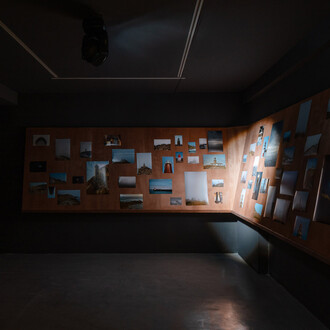Novus marks the final exhibition of the current season at Espacio Mínimo gallery. It is a project carried out in collaboration with the Faculty of Fine Arts at the Complutense University of Madrid, introducing a selection of proposals by undergraduate and master's students.
The exhibition is part of the Faculty's cultural action programme, De par en par, as a satellite activity to the academic year's closing exhibitions. Its aim is to bring excellence and emerging talent into the professional art circuit.
Seven new voices begin their exhibition journey in a gallery that embraces diverse media, languages, and themes in artistic practice. It is an inclusive and plural selection that reflects the formal and conceptual concerns of a new generation of artists.
Carmen Ojeda Martínez (Seville, 2000) presents a graphic project rooted in sociological reflection, based on the everyday ritual of extending shared time after meals. La Sobremesa: cómo permanecer is a setting for encounters and dialogue, allowing for the transmission of knowledge and values. It creates a space of resistance and transformation in contrast to individualistic and hyperproductive dynamics. From this premise, the artist creates a series of monotypes resembling tablecloths upon which crystal glasses rest—each print serving as an archaeological record of what transpired.
Gardo Martínez Román (Puerto Rico, 2000) reinterprets the visual and mystical language of tarot, drawing from the graphic tradition of political activism and protest posters to denounce colonial conflict, violence, and the resilience of the Puerto Rican people. Each card represents a political or social trauma of the island, where color symbolism and ritualistic atmospheres intertwine the mystical with the political.
Ixone Gil (Pamplona, 2003) focuses her painting on both the value of the image and the way it is constructed. By confronting genres and exploring the tension between the real and the represented, she dissects and examines the overwhelming multiplicity of images that permeate and shape our daily lives. Through a varied collage of mirrored elements, she invites us to reflect, again and again, on the act of looking.
Jeisson S. Novoa (Bogotá, 1998) draws from the 2021 protests in Bogotá and the subsequent coverage by hegemonic media, which reduced systemic violence to cold statistics. Through digital animation, ironic polyurethane dolls, and hand-altered print works, he weaves together youth culture codes, nostalgic fragments, and statistical rhetoric to construct a “counter-narrative of insurgent sweetness” with a strong socio-political critique.
Manuel Olarte García (Marbella, 1980) explores fashion as a language rich with cultural, emotional, and political meaning. Situated between deconstruction and patchwork, his textile pieces transcend commerce to address, from an ethnographic perspective, issues such as identity, memory, finitude, and gender. His work proposes a deconstruction of gender in clothing—dissolving binaries and questioning the performativity of dress. Masculine and feminine elements merge, dissolve, and reform into hybrid garments that challenge hierarchies of gender, class, and consumption.
Pei Dang (Henan, 1992) reinterprets the iconographic codes of Western painting from an ecological and posthuman perspective. With a colorful and almost childlike aesthetic, her works contrast visual joy with melancholic and sinister undertones. Her art offers a critical reflection on ecosystem disappearance, the symbolic value of animals in culture, and the urgent need to imagine new ways of coexistence.
Taro (Tui, 2002) manipulates Polaroids through reverse development and removal from their frames, proposing a queer, ever-shifting, nonconformist narrative of the image. Through self-portraits, they explore the skin as a symbolic surface and identity as performative. Their work (ironically) fits within a critical view of visual normativity, offering alternatives to rethink imagery through the body, and the body as a mutable technology traversed by gender, desire, and power discourses.
















